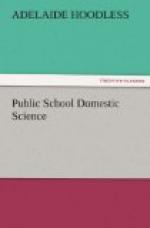Cooking of Meat.
(For more general information, see Recipes.)
In boiling meat two principles must be considered, the softening of the fibre and preserving of the juices. If the meat alone is to be used it should be placed in sufficient boiling water to completely cover, and kept at boiling point (212 deg. F.) for at least ten minutes, so as to harden the albumen and prevent the escape of the juices. The temperature should then be allowed to fall to simmering point (175 deg. F.). If the water is kept boiling it will render the meat tough and dry. If the juice is to be extracted and the broth used, the meat should be placed in cold water; if bones are added they should be cut or broken into small pieces in order that the gelatin may be dissolved. If the water is heated gradually the soluble materials are more easily dissolved. The albumen will rise as a scum to the top, but should not be skimmed off, as it contains the most nutriment and will settle to the bottom as sediment.
STEWING.
If both meat and broth are to be used the process of cooking should be quite different. In stewing, the meat should be cut into small pieces, put into cold water in order that the juices, flavoring material and fibre may be dissolved. The temperature should be gradually raised to simmering point and remain at that heat for at least three or four hours, the vessel being kept closely covered. Cooked in this way the broth will be rich, and the meat tender and juicy. Any suitable flavoring may be added. This is a good method for cooking meat containing gristle.
ROASTING AND BROILING.
When the meat alone is to be eaten, either roasting, broiling or frying in deep fat is a more economical method, as the juices are saved. The shrinkage in a roast of meat during cooking is chiefly due to a loss of water. A small roast will require a hotter fire than a larger one, in order to harden the exterior and prevent the juices from escaping. Meat is a poor conductor of heat, consequently a large roast exposed to this intense heat would become burned before the interior could be heated. The large roast should be exposed to intense heat for a few minutes, but the temperature should then be reduced, and long steady cooking allowed.
Broiling (see broiling in previous chapter, p. 19.)
Varieties of Meat.
BEEF TONGUE.
Beef tongue is a tender form of meat, but contains too much fat to agree well with people of delicate digestion.
VEAL.
Veal, when obtained from animals killed too young, is apt to be tough, pale and indigestible, but good veal is considered fairly nutritious. It contains more gelatin than beef, and in broth is considered valuable, especially for the sick.
MUTTON.
Mutton is considered to be more digestible than beef, that is well fed mutton from sheep at least three years old; but as it is more difficult to obtain tender mutton than beef, the latter is more generally preferred. Mutton broth is wholesome and valuable in sickness.




